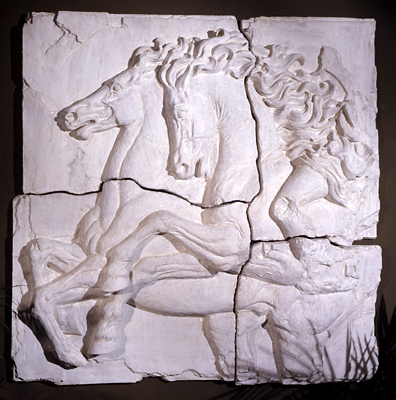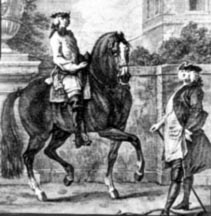
Riding in Lightness II
“How is it possible to elevate a horse’s withers, without pulling on the reins? And if I don’t pull, what is his incentive to lift his withers on his own? How do I ask him to make that weight transfer, from the front to the back, without actuallyinterfering with his ability to do so?” I realized I had so very much more to learn, if I wanted to help my horses to become the agile, fluid athletes I knew they had the potential to be.
"As there are no horses that, well ridden, cannot acquire lightness, when they lack it, it is to the horseman, and not to the structure of the mouth, that one must refer." Baucher
A light touch is the starting place of lightness. A young, green horse, freshly and correctly halter trained, is a delight. He understands how to respond to a fixed hand, and is a cooperative partner in restoring the slack in the line when he strays too far. He also understands the following hand, which accompanies him to and from his destinations, and he can follow the feel of a delicate request for a change of direction. These youngsters are often still very sensitive and sincere in their desire to give us their best. It’s our job not to violate that, to preserve that sensitivity, and the goodwill towards their human partner. The foundation of a good reining horse is begun in these initial encounters.
"All systems of practice resulting from force are to be condemned in equitation; the parts in contact have to hold their adhesion by their legitimate weight." Du Croc de Chabannes
The quality of the subsequent lunging and later bit work is dependent upon the tact we use with the lead rope and then the rein. A horse who has consistently been “asked” in a gentle and polite manner will offer sincere, polite responses. There is no need to increase pressure if this horse is non-responsive; he is naturally a sensitive animal, and can “hear” your request just fine. He either: 1) was not paying attention to you and missed the request; 2) heard you, but doesn’t understand your request 3) heard and understands you, but is not able to give you what you’ve requested at the moment. Each of these reasons require us, the human, to adjust our request, to make it more interesting, more specific, or timelier. Often, there is no need to increase the volume of force, only the tact of the delivery. There are specific gestures and indications which transmit these requests to the horse. Once the proper tact and timing of the delivery are understood by the human, the requests can be—and should be—delivered with the weight of the rein only.
Understanding how to deliver our request is, however, only half of the equation. What is it we wish to request? Collection of the horses’ forces? Squaring of his base of support? We next need to understand what physically needs to occur in the horse’s body, to produce a lightening of the withers, the transfer of the weight from front to back. If we know how to ask, do we know what to ask for?
"A good posture is a common possession of the horse and the rider, without which no art is possible, as it's a prerequisite thus it is lost. On the contrary, the art is identified by this condition, so that one could say: they are as one."
The key element to the second aspect of lightness is posture. The posture of the rider and the horse is paramount to the collection of his forces and the lightness with which he springs forth, and needs to be the subject of our attention. Posture can be affected by positioning the horse’s spinal column, and has been used by horsemen to either block or encourage particular movements. The most effective and direct way to affect a horse’s posture is by suggesting a location, the position, of his head via the rein aid. This is a medium the horse is already acquainted with (assuming halter training was done correctly), and, delivers the clearest, simplest message to the horse about your request.
"As there are no horses that, well ridden, cannot acquire lightness, when they lack it, it is to the horseman, and not to the structure of the mouth, that one must refer." Baucher
A light touch is the starting place of lightness. A young, green horse, freshly and correctly halter trained, is a delight. He understands how to respond to a fixed hand, and is a cooperative partner in restoring the slack in the line when he strays too far. He also understands the following hand, which accompanies him to and from his destinations, and he can follow the feel of a delicate request for a change of direction. These youngsters are often still very sensitive and sincere in their desire to give us their best. It’s our job not to violate that, to preserve that sensitivity, and the goodwill towards their human partner. The foundation of a good reining horse is begun in these initial encounters.
"All systems of practice resulting from force are to be condemned in equitation; the parts in contact have to hold their adhesion by their legitimate weight." Du Croc de Chabannes
The quality of the subsequent lunging and later bit work is dependent upon the tact we use with the lead rope and then the rein. A horse who has consistently been “asked” in a gentle and polite manner will offer sincere, polite responses. There is no need to increase pressure if this horse is non-responsive; he is naturally a sensitive animal, and can “hear” your request just fine. He either: 1) was not paying attention to you and missed the request; 2) heard you, but doesn’t understand your request 3) heard and understands you, but is not able to give you what you’ve requested at the moment. Each of these reasons require us, the human, to adjust our request, to make it more interesting, more specific, or timelier. Often, there is no need to increase the volume of force, only the tact of the delivery. There are specific gestures and indications which transmit these requests to the horse. Once the proper tact and timing of the delivery are understood by the human, the requests can be—and should be—delivered with the weight of the rein only.
Understanding how to deliver our request is, however, only half of the equation. What is it we wish to request? Collection of the horses’ forces? Squaring of his base of support? We next need to understand what physically needs to occur in the horse’s body, to produce a lightening of the withers, the transfer of the weight from front to back. If we know how to ask, do we know what to ask for?
"A good posture is a common possession of the horse and the rider, without which no art is possible, as it's a prerequisite thus it is lost. On the contrary, the art is identified by this condition, so that one could say: they are as one."
The key element to the second aspect of lightness is posture. The posture of the rider and the horse is paramount to the collection of his forces and the lightness with which he springs forth, and needs to be the subject of our attention. Posture can be affected by positioning the horse’s spinal column, and has been used by horsemen to either block or encourage particular movements. The most effective and direct way to affect a horse’s posture is by suggesting a location, the position, of his head via the rein aid. This is a medium the horse is already acquainted with (assuming halter training was done correctly), and, delivers the clearest, simplest message to the horse about your request.
The position which allows lightness to occur is elevation of the head and neck. A dropped or extended head and neck is the optimal position for speed and endurance. The elevated head and neck displaces the weight of the front of the horse, redistributes it, to reduce the weight of the front and increase the weight of the hind. This rebalancing and easing of the load in the front allows the horse a broader range of motion of his forelegs, making him light and available for his rider’s requests.
"Any breaking-in should start with the horse's head. From the head via the spinal column and the center of gravity goes the rider's influencing force to the horse's legs, and the more he is perfecting the communication, the more control he gets over the horse's feet…… When the head places itself as an answer to the rider's hand (the nose in place), the hocks unconditionally place themselves underneath the horse. The harmony that is the result from the advance of the head and the hind feet in this case is remarkable." Ehrengranat
Lightness is comprised of the loose rein, correct and fair indications used to request action from the horse, as well as collection of the forces, a squared base of support, elevation of the withers and full engagement of the hindquarters. The educated equestrian understands how to utilize both aspects of lightness to encourage an athletic, well-balanced horse who moves and works to the best of his ability.
Lightness is comprised of the loose rein, correct and fair indications used to request action from the horse, as well as collection of the forces, a squared base of support, elevation of the withers and full engagement of the hindquarters. The educated equestrian understands how to utilize both aspects of lightness to encourage an athletic, well-balanced horse who moves and works to the best of his ability.
2.10.12 TME
return to Educated Equestrian
return to Educated Equestrian
